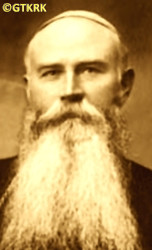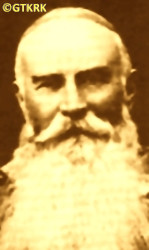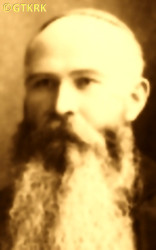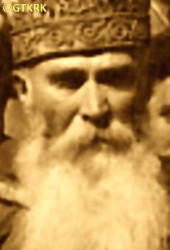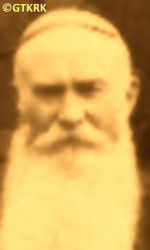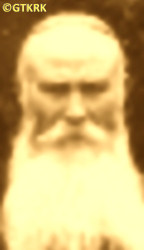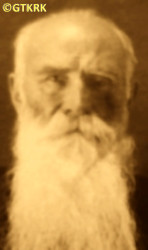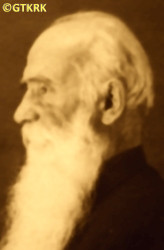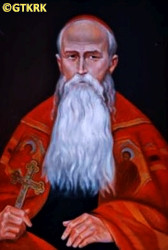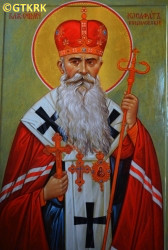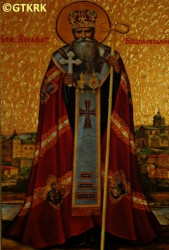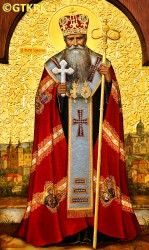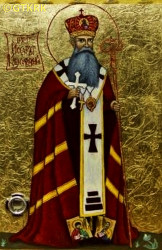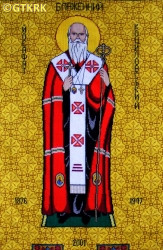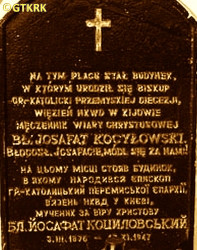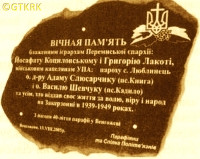Roman Catholic
St Sigismund parish
05-507 Słomczyn
85 Wiślana Str.
Konstancin deanery
Warsaw archdiocese, Poland
full list:
displayClick to display full list

searchClick to search full list by categories
wyświetlKliknij by wyświetlić pełną listę po polsku

szukajKliknij by przeszukać listę wg kategorii po polsku

Martyrology of the clergy — Poland
XX century (1914 – 1989)
personal data
religious status
blessed
surname
KOCYŁOWSKI
forename(s)
Joseph (pl. Józef)
religious forename(s)
Josaphat (pl. Jozafat)
beatification date
27.06.2001more on
www.swzygmunt.knc.pl
[access: 2013.05.19]

the RC Pope John Paul IImore on
en.wikipedia.org
[access: 2014.09.21]
function
bishop
creed
Ukrainian Greek Catholic GCmore on
en.wikipedia.org
[access: 2013.05.19]
congregation
Basilian Order of Saint Josaphat OSBMmore on
en.wikipedia.org
[access: 2014.09.21]
(i.e. Basilians)
diocese / province
Przemyśl GC eparchymore on
pl.wikipedia.org
[access: 2013.05.19]
academic distinctions
Doctor of Philosophy
Doctor of Theology
nationality
Ukrainian
date and place
of death
17.11.1947

Chapaivkatoday: Vita Litovska, part of Kiev, Holosiivskyi rai., Kiev city obl., Ukraine
more on
uk.wikipedia.org
[access: 2020.07.31]
alt. dates and places
of death
Lvivtoday: Lviv urban hrom., Lviv rai., Lviv obl., Ukraine
more on
en.wikipedia.org
[access: 2022.01.16]
details of death
After German and Russian invasion of Poland in 09.1939 and start of the World War II, after fall of Poland remained in Russian–occupied part of his eparchy.
After German attack on 22.06.1941 of their erstwhile ally, Russians, welcomed German troops and issued an announcement, including an eulogy: „Hail to the great führer Adolf Hitler, liberator and best friend of Ukrainian nation”.
Soon however realised a true nature of German occupation and started working with Polish bishops ministering in German‐run General Governorate.
Suspecting him of helping Jews Germans warned him of impeding arrest but did not bow.
After the end of military hostilities of the World War II, after German defeat and start of another Russian occupation, during preparations for a outlawing of Greek Catholic Church, arrested on 20/21.09.1945 in Przemyśl by Commie‐Nazi UB, Polish unit of Russian genocidal NKVD.
On the same day transported to Rzeszów prison.
On 17.01.1946 driven to Medyka on prl border, and next day, on 18.01.1946, handed over to the Russian NKVD.
Taken to Mostyska.
On 24.01.1946 released — the arrest orders had not arrived in time.
On 26.06.1946 — after formal outlawing of Greek Catholic Church and incorporating its structures into Russian Orthodox church on the territories directly occupied by the Russian, e.g. in Ukraine — arrested in Przemyśl, with Bp Lakota among others, again by UB, led by a Russian MGB (successor of NKVD) officer.
On the same day transported out — through Medyka again — to Lviv.
There held in prison and next transported to Kiev Lukyanivska prison.
There on 05.07.1946 formally arrested.
On 21.02.1947 tried by MGB cangaroo summary court in Kiev — accused of „betrayal of the Ukrainian people, cooperation with the Nazis and espionage for the Vatican”.
Sentenced to 10 years of slave labour in Russian concentration camps — Gulag.
Before being deported, however, was already seriously ill and died in a camp (prob. a prison camp) in the village of Chapaivka, on the outskirts of Kiev (or in a prison hospital).
Buried at the prison cemetery in Vita–Poshtova n. Kiev.
cause of death
extermination
perpetrators
Russians
sites and events
GulagClick to display the description, Kiev (Lyukyanivska)Click to display the description, Lviv (Brygidki)Click to display the description, RzeszówClick to display the description, GeneralgouvernementClick to display the description, Ribbentrop‐MolotovClick to display the description, Pius XI's encyclicalsClick to display the description
date and place
of birth
03.03.1876Birth certification on:
photos.szukajwarchiwach.gov.pl
[access: 2025.03.07]

Pakoszówkatoday: Sanok gm., Sanok pov., Subcarpathia voiv., Poland
more on
en.wikipedia.org
[access: 2021.12.18]
parents
KOCYŁOWSKI Peter
🞲 1845, Pakoszówkatoday: Sanok gm., Sanok pov., Subcarpathia voiv., Poland
more on
en.wikipedia.org
[access: 2021.12.18] — 🕆 1915, Glinnetoday: Lesko gm., Lesko pov., Subcarpathia voiv., Poland
more on
en.wikipedia.org
[access: 2025.01.29]

KOSAR Catherine
🞲 ?, ? — 🕆 ?, ?
baptism
05.03.1876Birth certification on:
photos.szukajwarchiwach.gov.pl
[access: 2025.03.07]

Lalintoday: Sanok gm., Sanok pov., Subcarpathia voiv., Poland
more on
en.wikipedia.org
[access: 2022.01.16]
St George the Martyr GC church
religious vows
16.05.1913 (temporary)
13.06.1916 (permanent)
presbyter (holy orders)
ordination
09.10.1907

positions held
1917 – 1947
bishop — Przemyśl, Sambir and Sanok GK eparchy — appointment: on 29.01.1917; ordination: on 23.09.1917, in the Birth of the John the Baptist cathedral in Przemyśl
1914 – 1917
rector — Kroměřížtoday: Kroměříž dist., Zlín reg., Czechia
more on
en.wikipedia.org
[access: 2022.01.22] ⋄ Greek Catholic Theological Seminary — for refugees from three Greek Catholic eparchies in Galicia
c. 1914
monk — Lavrivtoday: Staryi Sambir urban hrom., Sambir rai., Lviv obl., Ukraine
more on
en.wikipedia.org
[access: 2022.08.06] ⋄ Basilians OSBM ⋄ St Onuphrius GC monastery — lecturer at the clerical study
c. 1913
monk — Lvivtoday: Lviv urban hrom., Lviv rai., Lviv obl., Ukraine
more on
en.wikipedia.org
[access: 2022.01.16] ⋄ Basilians OSBM ⋄ GC monastery — lecturer at the clerical study
1911 – c. 1913
novitiate — Krekhivtoday: Zhovkva urban hrom., Lviv rai., Lviv obl., Ukraine
more on
en.wikipedia.org
[access: 2022.08.06] ⋄ St Nicholas GC monastery, Basilians OSBM
from 02.10.1911
monk — Basilians OSBM
1907 – 1911
vice–rector — Stanislavivtoday: Ivano‐Frankivsk, Stanislaviv/Ivano‐Frankivsk rai., Stanislaviv/Ivano‐Frankivsk obl., Ukraine
more on
en.wikipedia.org
[access: 2020.11.20] ⋄ Greek Catholic Theological Seminary — lecturer in dogmatic theology
till 1907
PhD student — Rometoday: Rome prov., Lazio reg., Italy
more on
en.wikipedia.org
[access: 2021.12.18] ⋄ theology, „Angelicum” [i.e. Lat. Pontificia Universitas Studiorum a Sancto Thoma Aquinate in Urbe (Eng. Pontifical University of St Thomas Aquinas) (today) / Lat. Pontificium Institutum Internationale (Eng. Pontifical International Institute) (1926‐1963) / Lat. Pontificium Collegium (Eng. Pontifical College) (1906‐1926) / Lat. Collegium (Eng. College) (until 1906)]
till 1903
PhD student — Rometoday: Rome prov., Lazio reg., Italy
more on
en.wikipedia.org
[access: 2021.12.18] ⋄ philosophy, „Angelicum” [i.e. Lat. Pontificia Universitas Studiorum a Sancto Thoma Aquinate in Urbe (Eng. Pontifical University of St Thomas Aquinas) (today) / Lat. Pontificium Institutum Internationale (Eng. Pontifical International Institute) (1926‐1963) / Lat. Pontificium Collegium (Eng. Pontifical College) (1906‐1926) / Lat. Collegium (Eng. College) (until 1906)]
1901 – 1907
student — Rometoday: Rome prov., Lazio reg., Italy
more on
en.wikipedia.org
[access: 2021.12.18] ⋄ philosophy and theology, Ukrainian Pontifical College of St Josaphat /from 1932/, St Josaphat College /till 1932/, Pontifical Rutheanum College/till 1904/
1900 – 1901
soldier — Lvivtoday: Lviv urban hrom., Lviv rai., Lviv obl., Ukraine
more on
en.wikipedia.org
[access: 2022.01.16] ⋄ garrison, Austro–Hungarian Imperial Army
1898 – 1900
cadet — Viennatoday: Vienna state, Austria
more on
en.wikipedia.org
[access: 2020.07.31] ⋄ artillery school, Imperial and Royal Technical Military Academy — graduation in the rank of second lieutenant
1896 – 1898
student — Lvivtoday: Lviv urban hrom., Lviv rai., Lviv obl., Ukraine
more on
en.wikipedia.org
[access: 2022.01.16] ⋄ law, John Casimir University [i.e. clandestine John Casimir University (1941‐1944) / Ivan Franko University (1940‐1941) / John Casimir University (1919‐1939) / Franciscan University (1817‐1918)]
others related
in death
ŁAKOTAClick to display biography Gregory, RESZETYŁOClick to display biography Roman
sites and events
descriptions
Gulag: The acronym Gulag comes from the Rus. Главное управление исправительно‐трудовых лагерей и колоний (Eng. Main Board of Correctional Labor Camps). The network of Russian concentration camps for slave labor was formally established by the decision of the highest Russian authorities on 27.06.1929. Control was taken over by the OGPU, the predecessor of the genocidal NKVD (from 1934) and the MGB (from 1946). Individual gulags (camps) were often established in remote, sparsely populated areas, where industrial or transport facilities important for the Russian state were built. They were modeled on the first „great construction of communism”, the White Sea‐Baltic Canal (1931‐1932), and Naftali Frenkel, of Jewish origin, is considered the creator of the system of using forced slave labor within the Gulag. He went down in history as the author of the principle „We have to squeeze everything out of the prisoner in the first three months — then nothing is there for us”. He was to be the creator, according to Alexander Solzhenitsyn, of the so‐called „Boiler system”, i.e. the dependence of food rations on working out a certain percentage of the norm. The term ZEK — prisoner — i.e. Rus. заключенный‐каналоармец (Eng. canal soldier) — was coined in the ITL BelBaltLag managed by him, and was adopted to mean a prisoner in Russian slave labor camps. Up to 12 mln prisoners were held in Gulag camps at one time, i.e. c. 5% of Russia's population. In his book „The Gulag Archipelago”, Solzhenitsyn estimated that c. 60 mln people were killed in the Gulag until 1956. Formally dissolved on 20.01.1960. (more on: en.wikipedia.orgClick to attempt to display webpage
[access: 2024.04.08])
Kiev (Lyukyanivska): Russian political prison in Kiev, in the first half of 20th century run by the genocidal NKVD, informally referred to as prison No 1, formally as Investigative Prison No 13 (SIZO#13). It was founded in the early 19th century. In the 20th century, during the Soviet times, the prison church was transformed into another block of cells. During the reign of J. Stalin in Russia, more than 25,000 prisoners passed through it. (more on: en.wikipedia.orgClick to attempt to display webpage
[access: 2014.09.21])
Lviv (Brygidki): Penal prison, then at 34 Kazimierzowska Str. in Lviv — in the buildings of the former monastery of the Order of St Brigid, in 1784 — after the first partition of Poland and after the dissolution of the religious orders as part of the so—called Josephine dissolutions — converted by the partitioning Austrian authorities into a prison. In 1939‐1941, the Russians held there thousands of prisoners, most of them Poles. On c. 26.06.1941, in the face of the German invasion and attack of their erstwhile ally, the Russians, during a panic escape (the left Lviv exactly on 26.06.1941), genocideally murdered several thousand prisoners. In 1941‐1944 the prison was run by the Germans and mass murders of Polish, Jewish and Ukrainian civilians took place there. After start of another Russian occupation in 1941 prison in which the executions were carried out on prisoners sentenced to death. (more on: en.wikipedia.orgClick to attempt to display webpage
[access: 2014.09.21])
Rzeszów: During German occupation penal prison run by the Germans set up in Rzeszów Castle. At any one time more than 2,500 prisoners were held there (for instance from 01.04.1943 till 01.03.1944), mainly Poles. In the Castle basements and on prison yard executions were carried out of those sentenced by the German Sondergericht (Eng. special court) kangaroo court — other prisoners of the Castle were executed by the Germans at other sites in Rzeszów as well. After German withdrawal on 02.08.1944 and capture of Rzeszów by the Russians the prison was taken over initially by the Russian genocidal NKVD and then by Polish UB, a unit of murderous Russian NKVD. Thousands, of prisoners — Polish political activists and partisans, members of various clandestine organizations (among others from Home Army AK, part of Polish Clandestine State, and Freedom and Independence WiN) — were then held captive there. Local AK leader, Col. Lukas Ciepliński, future chairman of 4th Command of WiN, murdered by Commie‐Nazis in 1951, reported in 1944 that „during interrogations even women are brutally beaten. The processes […] are led by NKVD” and „the prisoners’ situation […] is dreadful. They simply perish from hunger. The food in German times compared to today was simply a luxury”. Executions of those held — Polish independence activists, but also German war criminals and Ukrainian nationalist — were also, as done by the Germans, carried out then in the Castle, in Castle’s basements and on the gallows in the prison yard. (more on: www.sw.gov.plClick to attempt to display webpage
[access: 2013.12.04])
Generalgouvernement: After the Polish defeat in the 09.1939 campaign, which was the result of the Ribbentrop‐Molotov Pact and constituted the first stage of World War II, and the beginning of German occupation in part of Poland (in the other, eastern part of Poland, the Russian occupation began), the Germans divided the occupied Polish territory into five main regions. In two of them new German provinces were created, two other were incorporated into other provinces. However, the fifth part was treated separately, and in a political sense it was supposed to recreate the German idea from 1915 (during World War I, after the defeat of the Russians in the Battle of Gorlice in 05.1915) of creating a Polish enclave within Germany. Illegal in the sense of international law, i.e. Hague Convention, and public law, managed by the Germans according to separate laws — especially established for the Polish Germ. Untermenschen (Eng. subhumans) — till the Russian offensive in 1945 it constituted part of the Germ. Großdeutschland (Eng. Greater Germany). Till 31.07.1940 formally called Germ. Generalgouvernement für die besetzten polnischen Gebiete (Eng. General Government for the occupied Polish lands) — later simply Germ. Generalgouvernement (Eng. General Governorate), as in the years 1915‐1918. From 07.1941, i.e. after the German attack on 22.06.1941 against the erstwhile ally, the Russians, it also included the Galicia district, i.e. the Polish pre‐war south‐eastern voivodeships. A special criminal law was enacted and applied to Poles and Jews, allowing for the arbitrary administration of the death penalty regardless of the age of the „perpetrator”, and sanctioning the use of collective responsibility. After the end of the military conflict of the World War UU, the government of the Germ. Generalgouvernement was recognized as a criminal organization, and its leader, governor Hans Frank, guilty of war crimes and crimes against humanity and executed. (more on: en.wikipedia.orgClick to attempt to display webpage
[access: 2024.12.13])
Ribbentrop‐Molotov: Genocidal Russian‐German alliance pact between Russian leader Joseph Stalin and German leader Adolf Hitler signed on 23.08.1939 in Moscow by respective foreign ministers, Mr. Vyacheslav Molotov for Russia and Joachim von Ribbentrop for Germany. The pact sanctioned and was the direct cause of joint Russian and German invasion of Poland and the outbreak of the World War II in 09.1939. In a political sense, the pact was an attempt to restore the status quo ante before 1914, with one exception, namely the „commercial” exchange of the so‐called „Kingdom of Poland”, which in 1914 was part of the Russian Empire, fore Eastern Galicia (today's western Ukraine), in 1914 belonging to the Austro‐Hungarian Empire. Galicia, including Lviv, was to be taken over by the Russians, the „Kingdom of Poland” — under the name of the General Governorate — Germany. The resultant „war was one of the greatest calamities and dramas of humanity in history, for two atheistic and anti‐Christian ideologies — national and international socialism — rejected God and His fifth Decalogue commandment: Thou shall not kill!” (Abp Stanislav Gądecki, 01.09.2019). The decisions taken — backed up by the betrayal of the formal allies of Poland, France and Germany, which on 12.09.1939, at a joint conference in Abbeville, decided not to provide aid to attacked Poland and not to take military action against Germany (a clear breach of treaty obligations with Poland) — were on 28.09.1939 slightly altered and made more precise when a treaty on „German‐Russian boundaries and friendship” was agreed by the same murderous signatories. One of its findings was establishment of spheres of influence in Central and Eastern Europe and in consequence IV partition of Poland. In one of its secret annexes agreed, that: „the Signatories will not tolerate on its respective territories any Polish propaganda that affects the territory of the other Side. On their respective territories they will suppress all such propaganda and inform each other of the measures taken to accomplish it”. The agreements resulted in a series of meeting between two genocidal organization representing both sides — German Gestapo and Russian NKVD when coordination of efforts to exterminate Polish intelligentsia and Polish leading classes (in Germany called «Intelligenzaktion», in Russia took the form of Katyń massacres) where discussed. Resulted in deaths of hundreds of thousands of Polish intelligentsia, including thousands of priests presented here, and tens of millions of ordinary people,. The results of this Russian‐German pact lasted till 1989 and are still in evidence even today. (more on: en.wikipedia.orgClick to attempt to display webpage
[access: 2015.09.30])
Pius XI's encyclicals: Facing the creation of two totalitarian systems in Europe, which seemed to compete with each other, though there were more similarities than contradictions between them, Pope Pius XI issued in 03.1937 (within 5 days) two encyclicals. In the „Mit brennender Sorge” (Eng. „With Burning Concern”) published on 14.03.1938, condemned the national socialism prevailing in Germany. The Pope wrote: „Whoever, following the old Germanic‐pre‐Christian beliefs, puts various impersonal fate in the place of a personal God, denies the wisdom of God and Providence […], whoever exalts earthly values: race or nation, or state, or state system, representatives of state power or other fundamental values of human society, […] and makes them the highest standard of all values, including religious ones, and idolizes them, this one […] is far from true faith in God and from a worldview corresponding to such faith”. On 19.03.1937, published „Divini Redemptoris” (Eng. „Divine Redeemer”), in which criticized Russian communism, dialectical materialism and the class struggle theory. The Pope wrote: „Communism deprives man of freedom, and therefore the spiritual basis of all life norms. It deprives the human person of all his dignity and any moral support with which he could resist the onslaught of blind passions […] This is the new gospel that Bolshevik and godless communism preaches as a message of salvation and redemption of humanity”… Pius XI demanded that the established human law be subjected to the natural law of God , recommended the implementation of the ideal of a Christian state and society, and called on Catholics to resist. Two years later, National Socialist Germany and Communist Russia came together and started World War II. (more on: www.vatican.vaClick to attempt to display webpage
[access: 2023.05.28], www.vatican.vaClick to attempt to display webpage
[access: 2023.05.28])
sources
personal:
www.vox-populi.com.uaClick to attempt to display webpage
[access: 2014.09.21], pl.wikipedia.orgClick to attempt to display webpage
[access: 2013.05.19], photos.szukajwarchiwach.gov.plClick to attempt to display webpage
[access: 2025.03.07]
original images:
commons.wikimedia.orgClick to attempt to display webpage
[access: 2019.12.26], mtrojnar.rzeszow.opoka.org.plClick to attempt to display webpage
[access: 2019.12.26], commons.wikimedia.orgClick to attempt to display webpage
[access: 2019.12.26], www.osbm.org.uaClick to attempt to display webpage
[access: 2019.12.26], osbm.in.uaClick to attempt to display webpage
[access: 2019.12.26], osbm.in.uaClick to attempt to display webpage
[access: 2019.12.26], uk.wikipedia.orgClick to attempt to display webpage
[access: 2019.12.26], uk.wikipedia.orgClick to attempt to display webpage
[access: 2019.12.26], catholicnews.org.uaClick to attempt to display webpage
[access: 2019.12.26], josaphatschool.at.uaClick to attempt to display webpage
[access: 2019.12.26], homilia.io.uaClick to attempt to display webpage
[access: 2019.12.26], www.osbm.org.uaClick to attempt to display webpage
[access: 2019.12.26], catholicnews.org.uaClick to attempt to display webpage
[access: 2019.12.26], blazejowskyj.comClick to attempt to display webpage
[access: 2019.12.26], zabytki-podkarpacie.plClick to attempt to display webpage
[access: 2021.12.19], www.vox-populi.com.uaClick to attempt to display webpage
[access: 2020.01.26]
LETTER to CUSTODIAN/ADMINISTRATOR
If you have an Email client on your communicator/computer — such as Mozilla Thunderbird, Windows Mail or Microsoft Outlook, described at WikipediaPatrz:
en.wikipedia.org, among others — try the link below, please:
LETTER to CUSTODIAN/ADMINISTRATORClick and try to call your own Email client
If however you do not run such a client or the above link is not active please send an email to the Custodian/Administrator using your account — in your customary email/correspondence engine — at the following address:

giving the following as the subject:
MARTYROLOGY: KOCYŁOWSKI Joseph
To return to the biography press below:
 Click to return to biography
Click to return to biography








